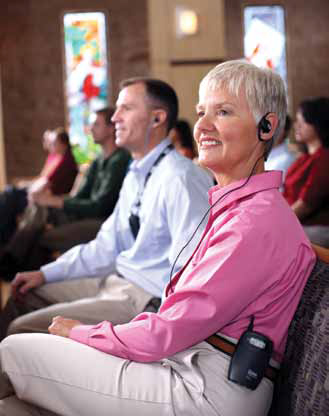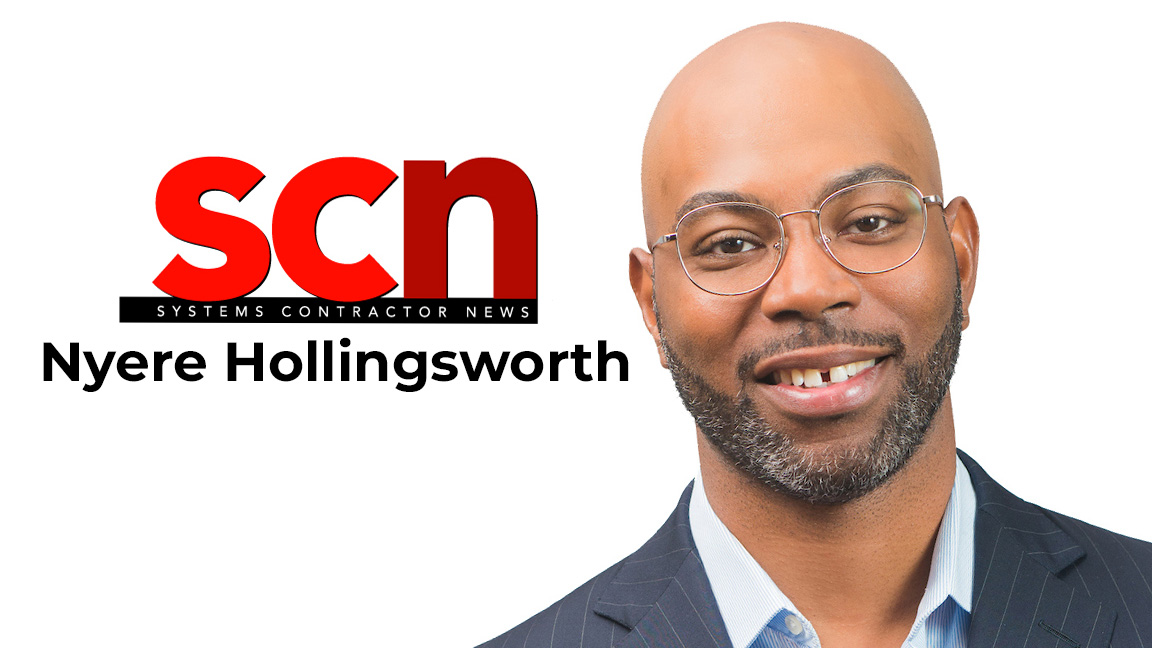If There’s an Assembly, There’s an Assistive Listening Requirement

Just like those holiday fruitcakes, it’s a given: take a glimpse around any large gathering this season and you will be looking at least a few people who are hearing impaired.
It is estimated that only half of the house of worship market has a hearing assistance system installed, which offers tremendous opportunity
for upgrades to meet new requirements for assembly areas where audible communication is integral to use. “The ADA has required assistive
listening systems since 1990, but in 2010 changes were made to the ADA and in 2012 those changes went into full effect,” said Cory Schaeffer, co-founder of Listen Technologies.
Now that assistive listening is required in just about any room with more than a few seats, shouldn’t all AV integrators be adding these products to their lineup? The answer is a resounding “absolutely”.
“The ADA has required ALS (assistive listening systems) since 1990, but in 2010 changes were made to the ADA, and in 2012 those changes went into full effect,” said Cory Schaeffer, co-founder and vice president of worldwide sales for Listen Technologies. “With all the dates, numbers, and requirements, there has been some confusion as far as why it’s important to include assistive listening into an AV integrator’s lineup of products, but it’s more important than ever that ALS be included.”
ALS is an easy add-on to a system installation and generally a very small component of an overall budget. “Having an accessible facility boosts attendance or participation, which ultimately boosts income for the facility,” noted Paul Ingebrigtsen, president and CEO of Williams Sound.
For the client, the add-on is advantageous from a PR standpoint and makes financial sense. “If you can increase attendance and more people spend money or contribute money at a facility, the ALS ultimately pays for itself,” he said. “It also means the facility is in compliance with applicable legislation, so they reduce the risks associated with not being in compliance, which can include bad publicity and, ultimately, lawsuits. Lawsuits have driven compliance in the cinema industry.”
Who’s On First?
A daily selection of the top stories for AV integrators, resellers and consultants. Sign up below.
Which vertical markets will be the first to adapt? It’s a toss-up as adoption is well underway across the board.
“HOWs are driven more by the desire to offer the service and encourage attendance than they are by mandated compliance,” Ingebrigtsen said. “Cinemas and theaters have high adoption rates, both out of a desire to be in compliance and to encourage attendance, which means more paying customers. Government facilities and courtrooms, where there is language diversity, are steadily gaining adoption, driven by accessibility requirements and a need for the service.”
A related market is language interpretation, as many facilities that need hearing accessibility also need language accessibility. “A recent FCC rule change in the U.S. recognizes that these applications are often one and the same, and now allow FM hearing assistance systems also to be used for simultaneous language interpretation,” he explained.
Some notable trends have emerged as ALS is implemented, Schaeffer said. “Managers at performing arts venues—architects, educators, and HOW leaders—all have been quite interested because they see the mutual benefits that ALS can provide. The International Association of Venue Managers, for example, has been quite proactive in educating themselves on ADA requirements and ALS, especially when it comes to installing them in newer projects, such as theaters, stadiums, and convention centers.
This is a smart move, he added, given that those with hearing loss have family and friends who will attend events with them “So a venue manager is meeting ADA requirements and making a wise business decision.”
Educators will be quick to adapt because the soundfield market now requires that all soundfield applications meet the ADA standards. “Soundfield systems were originally marketed to help students with hearing loss,” Schaeffer explained, “and the results showed that all students improved in retention and productivity. The soundfield technology market has exploded over the past 10 years, so there is great and continuing opportunity in this vertical market.”
It takes understanding the variety of products and technologies to be in this market, said Tim Ridgway, vice president of marketing for Califone International. “We make systems for the most widely used technologies. UH F systems and FM systems have a good range and can also be used for language interpretation, but some might find the ability to transmit through walls to be an issue. IR systems transmit a signal that doesn’t go through walls. For schools, installing multiple systems into adjoining classrooms is a plus, so there’s no bleed from one system to the next.”
In the Loop
If everything old is new again, that includes loop technology, simple to use and a good addition to other assistive listening devices.
The loop is a great opportunity for integrators, Ingebrigtsen said. “Local grassroots support from consumer hearing loss groups and funding efforts have allowed some integrators to set up a specialized team that does nothing but loop installations.”
Loop systems do require a site survey, design, and installation, all value-added activities for integrators. “It’s not just box shifting and price competition,” he noted. “Loop systems do require training for proper design and installation, so this is an added demand on integrators. Without the correct design and installation knowledge, installation cost overruns, do-overs, and general headaches will quickly erase any profit the integrator can make.”
The popularity of loops is on the increase in the U.S., likely due to better installation standards which provide an improved user experience for people with smart hearing aids equipped with T-coils or those users with cochlear implants.
For integrators, this means that loops can be installed in less traditional spaces, such as taxicabs, ticket counters, and trains, Schaeffer said. “AV integrators must be aware that with this comes the responsibility of proper installation. There’s no point in installing a loop if it isn’t going to work as well as it possibly should. We offer hearing loop installation training courses that train integrators to the IEC installation standards.”
Architects are becoming more relevant to the ALS discussion, particularly in regard hearing loops. “The reason is because if a hearing loop is the system of choice it needs to be considered in the initial design and planning phase of a building,” Ingebrigtsen said. “At the end of the day, whether an integrator is installing a loop or providing a RF or an IR ALS, understanding why assistive listening is needed is an integral part of this industry; it helps people with hearing loss have better lives.
“It’s very important for AV integrators to be advocates for people with hearing loss; they need to understand that any time they’re working on a project where ALS is being installed, they’re helping provide a better experience for someone. This kind of knowledge and expertise will also create more opportunity.”
Karen Mitchell is a freelance writer living in Boulder, CO.
An ADA FAQ
Here’s a primer on what an AV integrator should know about the ADA requirements, courtesy of Cory Schaeffer, co-founder and vice president of worldwide sales for Listen Technologies:
In any assembly area where audible communication is integral to use, an assistive listening system (ALS) shall be provided. The ADA doesn’t specify what type of technology this has to be. Second, 25 percent minimum of receivers provided, but no fewer than two, shall be hearing-aid compatible. This requirement can be accomplished by providing a personal neck loop or by installing a hearing loop with receivers for those who do not have smart hearing aids.
Each assembly area required to provide assistive listening shall provide signs informing patrons of the availability of the ALS. These signs shall comply with the International Symbol of Access for Hearing Loss. “We recently created a tool kit for venues that include these signs,” Schaeffer said. “It allows them easier access and also helps promote more awareness, which is something that we’re quite passionate about.”
The assembly areas include, but are not limited to: classrooms, lecture halls, courtrooms, public meeting rooms, legislative chambers, motion picture houses, auditoria, theaters, playhouses, dinner theaters, concert halls, performing arts centers, amphitheaters, arenas, stadiums, grandstands, and convention centers. —K.M.
Ear to the Ground

The education market is one that many AV integrators may already be serving, but perhaps they haven’t yet considered providing ALS products, noted Califone’s
Tim Ridgway. Listen carefully and you’ll hear the sweet sound of opportunity beckoning you to get into the assistive listening systems (ALS) market, where prospects are plentiful. In this broad segment, it may surprise you to learn, for instance, that only half of the house of worship market has a hearing assistance system installed.
The education sector provides another example of an opportunity not yet served. “The education market is one many AV integrators may already be serving, but perhaps they haven’t yet considered this type of product,” Califone’s Tim Ridgway explained. “Whether for larger assembly or performing arts rooms, or for individual classrooms, there is adequate demand. Opportunities are plenty; with over 14,000 school districts nationally, there’s lots of room for AV integrators.”
Entering the assistive listening market is a pretty easy transition for AV integrators as FM systems are straightforward to install and do not require a lot of design analysis, said Williams Sound’s Paul Ingebrigtsen. “Infrared systems require some design thought and more installation time than FM systems. Loop systems require very careful design and often complex installation techniques, and most manufacturers offer design training, and some require installer training, in order to sell the loop products.”
In addition to making ALS a part of every project, it’s essential to fully understand the attendant ADA requirements. “Often there’s a perception that if an AV integrator provides information about something that isn’t asked for by a client, the client will feel as if the integrator is trying to oversell them, but assistive listening should be looked at differently,” noted Cory Schaeffer, vice president of worldwide sales for Listen Technologies.
Opportunities are bolstered by the fact that assistive listening is required by law. “Integrators are doing their clients a great service by staying informed and sharing this information,” she added. “Approximately 17 percent of adult Americans have a measurable degree of hearing loss; it’s the largest disability covered under the ADA. With this knowledge, ALS’s simply make sense because so many people benefit from the technology. Integrators can build more opportunity for themselves by providing services with assistive listening signage, website content, education, and building more awareness among their clients and their colleagues.”
There also may be tax incentives for complying with the ADA requirements. The overall goal for AV integrators and their clients should be to get end-users— that 17-percent—to benefit from the provided systems and to feel completely comfortable using the technology.
“There are many tools to support AV integrators,” Schaeffer said. “We have seen many integrators add these systems into every project by starting with a letter which addresses the reasons why it’s important to include the technology, the ADA requirements, and the benefits to their clients. They then request that their client sign off on the system, which has been viewed as a great service as well as a great conversation starter. And we all know conversations are one of the best ways to create business opportunities.”
Understanding the differences between the various technologies, with the pros and cons of each, is important as well, Ingebrigtsen explained. “There is no one-size-fits-all solution. Ultimately, the integrator needs to correctly match the technology—FM, IR, or loop—to the venue, the needs of the audience, and the budget. Forcing in a bad technology choice ends up creating a very expensive solution that still does work optimally. With the latest network-controlled models, integrators also need to increase their knowledge in terms of system control networks.”
ALS’s provide two financial opportunities, first, as an incremental sale or a, “Do you want French fries with that?” deal sweetener. “Secondly, integrators have told us that this simple sale opens the door to additional sales opportunities,” he said. “It’s like a ‘gateway drug.’ The facility initially contacts them about an ALS, but once the integrator meets with them, they start talking about what else they need such as new mics, new speakers, new video displays, and sometimes even an entirely new system. So the ALS can be the ‘gateway drug.’”
—K.M.
